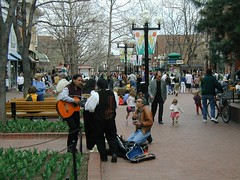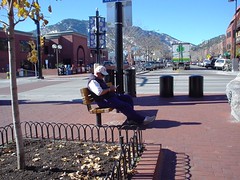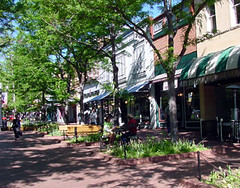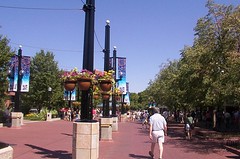How to f*** up 17th Street NW in Dupont Circle
Create a pedestrian mall.
Steve writes:
Have you read about this proposal to create a pedestrian mall on 17th Street? Looks like not the best idea to me. Even if it works, then you've got a 17th Street with MORE pressure to chain up just like Connecticut.
True dat, especially in that the inventory of commercial space is fixed, therefore pretty finite, and pretty miniscule to begin with. Although it would lead to the redevelopment of the McDonald's and building above the McDonald's and the Safeway..., as well as more harvesting of basements, and of second floors.
There is not one location in DC that has a consistently high enough pedestrian volume to make a pedestrian mall work. European city examples are irrelevant because of differences in mobility and weather patterns here, and the still prevalent use of the car (although Dupont Circle residents are less likely to drive compared to other DC neighborhoods). I'd love to have the balmy weather that Mediterreanean cities have, but we don't.
-----------------
Umm, one possible exception, but it is a new development, and would still require a lot of additional work to be successful, would be G Street between 7th and 9th Streets. But this is only because of the combination of retail, the Smithsonian Museums, possibly the Central Library, the Spy Museum, and the Verizon Center. Plus, I don't think we have it within our capacity yet in the various institutions that would be responsible for this to really make it work, at least right now.
------------------
Significantly, it is likely that the number of cars crossing the pedestrian malls in Boulder and Charlottesville (see Phase II Mall Crossing Cover & Back.ppt) are higher than the traffic along P, Q, and R Streets. The streets perpindicular to pedestrian malls allow traffic. And the Denver and Nicollet malls are major routes and staging areas for bus transit.
From the 17th Street website:
· The vast majority of people arriving at the businesses in the neighborhood already arrive on foot, not by car
· The area is dominated by independent restaurants and small shops, which would benefit by increased pedestrian traffic and the ability to use parts of the promenade for additional seating and space.
· The area is bounded on one end by residential areas and the other by dense office buildings, insuring use of the promenade for both lunchtime and evening/weekend activities.
· Minimal traffic and no metrobus routes currently exist on 17th Street, and traffic could easily be diverted to New Hampshire, 16th and 18th Streets with minimal disruption.
Pedestrian malls don't thrive because they are free of cars, they thrive because they are full of pedestrians. That's the dependent variable (the number of patrons on foot), not whether or not there are cars.
A typical summer weekend in Bouder sees 100,000+ visitors to the Pearl Street Mall. This happens week-in and week-out. I don't know what the patron counts are for Georgetown say at the Wisconsin and M Street intersection or at Connecticut and K Street or at Dupont Circle and Connecticut, but I will try to find out. (See "Pearl Street Mall. 2006 Pedestrian Count. Art Fair and Summer Weekend. Conducted for Downtown Boulder.")
And speaking of management, check out Downtown Boulder's Strategic Plan. From the report:
• Frequency of Downtown visits by intercept respondents has remained relatively high, ranging from 11.3 visits in the previous two-month period in 1999 to 12.8 visits in the previous two-month period in 2004.
• In 2004, the average out-of-state visitor spent $51.45, compared to a Boulder resident who spent an average of $26.78.
• In 2004, 43% of telephone survey respondents are visiting less frequently, while only 10% are visiting more frequently.
How many people visit Dupont Circle 11-12 times in two months?
Eastern Market, weekends only, I think could work as a pedestrian only place (except for vendor vehicles), just like the one of the public markets in Toronto.
The handful of pedestrian malls that do work in the United States do so because they are extremely well managed and programmed... and because they are next to places with high walking-dependent populations with somewhat reasonable disposable incomes--large universities--as well as a serving as a destination and entertainment center for in-region and out-of-region visitors. There are only 3-5 places that I know of where this works (where they aren't privatized places like The Grove in LA or City Walk in Santa Monica): Burlington, VT; Boulder, CO; Charlottesville, Denver (which is open to buses), and Nicollet Mall in Minneapolis (I don't know why it works, but I'll try to figure it out in October).
And as this blog entry shows, it works because they work very very diligently to make it work. We don't have the combination of soft and hard policies and programs to make something like this work in DC, not to mention, enough pedestrian traffic.
P.S. Shadyside in Pittsburgh and South Street in Philadelphia are examples of commercial districts that thrive, they seem like they are exclusive to pedestrians, but they are not. Shadyside is the #1 traditional commercial district in the Pittsburgh region. It's pretty chained up, and has experienced a phenomenal amount of second floor absorption as retail space--mostly for chains, but some independents.) It has parking, a city government parking structure, a metered lot in front of a strip shopping center on a side street, and bus service. (On the other hand, unlike Dupont Circle, it doesn't have a highly used subway station.) 17th Street NW does pretty well for restaurants, but it has minimal retail.
It would be interesting to do intercept studies of the patrons of the various restaurants. I am sure that places like Annie's get both in-area patrons as well as out-of-neighborhood patrons, same with the Sushi restaurant. But it's been years since I've eaten at places like Skewers. (I like Dupont Italian Kitchen and maybe eat there twice/year.) I miss the Pena Spanish Market... Anyway, I think most of the patronage is likely to be very local, and not likely to sustain an active public space devoid of cars.
-----------
See this reprint from 12/2005. My apologies that the original link to the article in the Longmont Daily Call Times is broken and I have never been able to restore the link.

Locals and tourists gather at Pearl Street Mall in Boulder. Photo By: Mark Ruckman, from Go Colorado.
In most instances across the U.S., pedestrian-only malls have been proven to be ineffective, and have been retrofitted to bring back automobiles as part of the mobility mix. That doesn't stop people from continuing to suggest them.
The problem with exclusively pedestrian streets is that sculptures and plants usually aren't enough to animate spaces if there aren't enough people present. And in the automobile-centric places that typify U.S. communities, few cities have enough population to begin with not to mention population present walking around on downtown streets to make a pedestrian mall work. Exceptions seem to be college towns like Charlottesville or Boulder, which have a nearby student population that is large, and more likely to walk than to drive (and less likely to own a car as well).
This article, "Still one-of-a-kind: Pearl Street Mall remains jewel in Boulder’s crown," from the Longmont Daily Times-Call, describes the Pearl Street Mall in Boulder and how it developed, and how it has changed over time.
I've mentioned in the past that there was an excellent case study about Boulder in the Main Street News publication, which has been reprinted in the book Marketing an Image for Main Street. This book is highly recommended to Main Street committee chairs and board members even more than the original Downtown Revitalization Handbook--as the former is better written and perhaps more to the point about what a commercial district revitalization program is trying to accomplish.
Getting back to the case study, knowing that a new mall would be opening and competing with Pearl Street, in the past few years the Pearl Street Mall BID conducted a variety of surveys and market studies to better determine the origins of their customers, finding for example that 35% of the customers live in the Denver-Boulder metropolitan area, and they come a few times/year, in large part because of the distinctive stores (indepndents for the most part, not chains) and the quality public spaces and street experiences (!!!!! -- note to people who are calling for more homogeneous experiences, that such diminishes the unique selling proposition that cities possess in goodly amounts -- unique experiences).
This helped the Boulder downtown commercial district better focus on strengthening their advantages, rather than becoming more diffuse.
From the article:
Today, the Pearl Street Mall and the rest of downtown Boulder are one of the most important districts in the city, not just for the sales taxes generated but for what Foy and other experts refer to as “sense of place.”

The view from Pearl Street. Photo by Lars Erik Finanger.
Foy, whose Boulder firm was instrumental in the design of the mall, said it’s important for any community seeking to reinvigorate a downtown to “find emotional triggers.” On Pearl Street, one of those triggers is the scenery...
The architecture and tenant mix, especially the independent businesses, are two more of those emotional triggers, said Bolduc. Old Chicago, which had its first location on Pearl Street, has since grown into a strong, multi-state chain. But chain stores and restaurants do not dominate Boulder’s downtown, despite what people might think.

City of Boulder photo.
In fact, 75 percent of the downtown area’s businesses are independent, according to Jane Jenkins of the Downtown Boulder Business Improvement District. “I think that is a misconception, and interestingly enough many of the stores that have closed down have been the chain stores,” she said.“... “When you walk around here it’s almost strange to see a chain here anymore,” said Bolduc. “And the ones you do see you don’t even recognize as chains. They might be smaller, regional chains.” ...
John Schopbach, owner of Weekends... believes chains are helpful to a district like downtown Boulder because familiar names indicate success to out- of-town visitors, making them more inclined to trust adjacent locally owned stores. “We need those names and we need that recognition for clothes shopping,” Schopbach said. “It needs to be a place to shop and not just a place to hang out.”
He also said it takes more than just having a presence downtown or on Pearl Street, to guarantee success. “You can’t just open up down here and expect to do a lot of business just because the Pearl Street Mall gives you a lot of traffic,” Schopbach said. “You’ve got to do a good job.” The vacancy rate for retail spots in downtown Boulder is about 5 percent, Jenkins said, with lease rates running the gamut but averaging somewhere in the mid-$30s per square foot. “I think that you have to have a good mix of local versus national, and I think in downtown Boulder we have exactly the right mix,” she said...
________
Note: these lease rates in a very successful commercial district are what property owners are asking for space in marginal commercial districts in Washington, DC
________
Fundamental success factors
“We have short blocks; we only did four (blocks, for the pedestrian mall),” she said. “And also, they let the north-south streets go through the mall. To me, that was the most critical thing that they did.” She added that having “interactive” elements on every block, such as street performers, boulders to climb or sit on and sculptures, makes for a lively experience for visitors. And for any downtown, the perception of success is critical. In Boulder’s case, building owners on the Pearl Street Mall have been encouraged to find retailers to lease their ground-floor [retail] storefronts.

City of Boulder photo.
Firms like Foy’s, and plenty of other service-oriented businesses like law offices and accountants, are located throughout the downtown, but they’re not on the ground floor, at least not on the pedestrian mall.
So, visitors who walk the mall after hours or on the weekends are not greeted with open businesses alternating with dark storefronts and “closed” signs.
From Denver Skyscrapers. Photo by Dan Malouff.
Clearly, there are reasons that the Pearl Street "pedestrian" Mall is wildly successful. They work their a**** off to ensure that it succeeds, leaving little to chance. Impressive.
Labels: public space management, urban design/placemaking, urban revitalization




0 Comments:
Post a Comment
<< Home